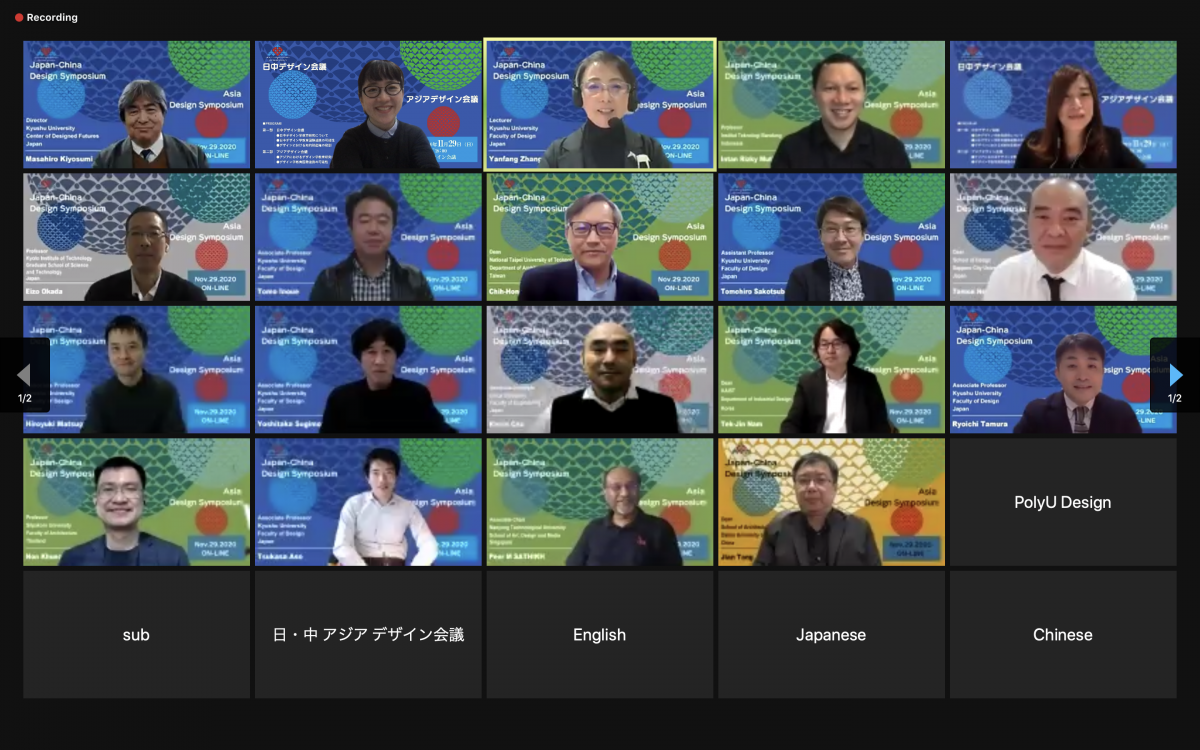ReportsAsian Design Symposium2021.4.12

After the “Japan-China Design Symposium” on the morning of November 29, 2020, the “Asian Design Symposium” was held in the afternoon. With the spread of COVID-19 in different countries, how is education being conducted now? We started by sharing information about the historical background of each country and what qualities are currently required of design professionals. A wide range of topics was also discussed, including the creation of new academic research fields through collaboration among design universities in Asia.
Sharing of Design Education and Research Initiatives in Asia
At the symposium, two universities in Japan and six universities in Asia made presentations on the origins and philosophy of their design faculties and the international collaboration they are engaged in. Although there are some differences in the situation in each country and the image of design-related human resources required by each country, it was confirmed that each university had shared awareness of the issues that need innovative ideas that are sensitive to social issues in today’s age of global information traffic.
Discussion
Collaboration among different fields (architecture, visual communication, industrial design)
All the universities were aware of the importance of collaboration. Still, there were differences in the smoothness of operation depending on whether the university itself was established on the premise of cooperation or whether collaboration was started later when a vertically divided curriculum was implemented. For example, at one university, a school for the disabled was placed at the project center. Students with different specialties, such as architecture, product design of nursing care equipment, and system design, were conducting joint research, which has been put to practical use. It was announced that the project had been put to practical use.
On the other hand, some universities felt that there were some problems. Even if students were in an environment where they could learn in a cross-cultural environment, researchers and faculty members who were required to be specialized and accurate tended not to mention other fields. Some universities also noted that it is difficult for cross-disciplinary research to be evaluated in terms of performance.
Possibility of building a network of design universities in Asia
The topic of building a platform for collaboration among universities across Asia naturally led to positive comments from each university, linking to the exchange of opinions on online classes and project implementation in the Corona disaster. The countermeasures against COVID-19 and the status of infection differed significantly from country to country. We learned that most universities are conducting classes using a hybrid of online and face-to-face methods depending on the occasion.
The advantages of online classes and projects include collaborating with excellent visiting professors from different countries and sharing content with institutions that have similar courses. On the other hand, some issues need to be addressed, such as not everyone has the same infrastructure and internet access, there are still not enough methods for those that require hands-on activities such as architecture and product design. The quality of exchange is still different from face-to-face interactions.
All the participants were positive about the idea of building a platform between design universities in Asia. In the current situation where it is difficult for universities to go back and forth to conduct research and study each other, there was an opinion that the existence of a human network would be of great benefit in education and research, and the role that the platform would play in this regard was confirmed to be significant. In addition, there was a positive suggestion to use this online platform to conduct some joint projects. There was also a proactive suggestion to use this online platform to do some collaborative projects. The discussion showed a growing momentum not just to sit and wait for post-Corona but to be proactive and do what we can
Date
November 29, 2020
<Participating Universities>
Kyushu University Faculty of Design
Chiba University
Kyoto Institute of Technology
KAIST, Korea
Institute of Technology, Bandung, Indonesia
The Hong Kong Polytechnic University
Nanyang Technological University, Singapore
Silpakorn University, Thailand
National Taipei University of Technology, Taiwan
You can view the digest version of the symposium below.
Contact
tsuruta.miwa.226@m.kyushu-u.ac.jp
